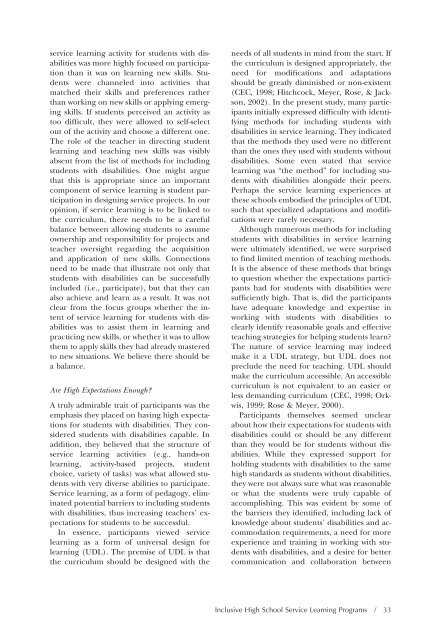Download the Journal (PDF) - Division on Autism and ...
Download the Journal (PDF) - Division on Autism and ...
Download the Journal (PDF) - Division on Autism and ...
Create successful ePaper yourself
Turn your PDF publications into a flip-book with our unique Google optimized e-Paper software.
service learning activity for students with disabilities<br />
was more highly focused <strong>on</strong> participati<strong>on</strong><br />
than it was <strong>on</strong> learning new skills. Students<br />
were channeled into activities that<br />
matched <str<strong>on</strong>g>the</str<strong>on</strong>g>ir skills <strong>and</strong> preferences ra<str<strong>on</strong>g>the</str<strong>on</strong>g>r<br />
than working <strong>on</strong> new skills or applying emerging<br />
skills. If students perceived an activity as<br />
too difficult, <str<strong>on</strong>g>the</str<strong>on</strong>g>y were allowed to self-select<br />
out of <str<strong>on</strong>g>the</str<strong>on</strong>g> activity <strong>and</strong> choose a different <strong>on</strong>e.<br />
The role of <str<strong>on</strong>g>the</str<strong>on</strong>g> teacher in directing student<br />
learning <strong>and</strong> teaching new skills was visibly<br />
absent from <str<strong>on</strong>g>the</str<strong>on</strong>g> list of methods for including<br />
students with disabilities. One might argue<br />
that this is appropriate since an important<br />
comp<strong>on</strong>ent of service learning is student participati<strong>on</strong><br />
in designing service projects. In our<br />
opini<strong>on</strong>, if service learning is to be linked to<br />
<str<strong>on</strong>g>the</str<strong>on</strong>g> curriculum, <str<strong>on</strong>g>the</str<strong>on</strong>g>re needs to be a careful<br />
balance between allowing students to assume<br />
ownership <strong>and</strong> resp<strong>on</strong>sibility for projects <strong>and</strong><br />
teacher oversight regarding <str<strong>on</strong>g>the</str<strong>on</strong>g> acquisiti<strong>on</strong><br />
<strong>and</strong> applicati<strong>on</strong> of new skills. C<strong>on</strong>necti<strong>on</strong>s<br />
need to be made that illustrate not <strong>on</strong>ly that<br />
students with disabilities can be successfully<br />
included (i.e., participate), but that <str<strong>on</strong>g>the</str<strong>on</strong>g>y can<br />
also achieve <strong>and</strong> learn as a result. It was not<br />
clear from <str<strong>on</strong>g>the</str<strong>on</strong>g> focus groups whe<str<strong>on</strong>g>the</str<strong>on</strong>g>r <str<strong>on</strong>g>the</str<strong>on</strong>g> intent<br />
of service learning for students with disabilities<br />
was to assist <str<strong>on</strong>g>the</str<strong>on</strong>g>m in learning <strong>and</strong><br />
practicing new skills, or whe<str<strong>on</strong>g>the</str<strong>on</strong>g>r it was to allow<br />
<str<strong>on</strong>g>the</str<strong>on</strong>g>m to apply skills <str<strong>on</strong>g>the</str<strong>on</strong>g>y had already mastered<br />
to new situati<strong>on</strong>s. We believe <str<strong>on</strong>g>the</str<strong>on</strong>g>re should be<br />
a balance.<br />
Are High Expectati<strong>on</strong>s Enough?<br />
A truly admirable trait of participants was <str<strong>on</strong>g>the</str<strong>on</strong>g><br />
emphasis <str<strong>on</strong>g>the</str<strong>on</strong>g>y placed <strong>on</strong> having high expectati<strong>on</strong>s<br />
for students with disabilities. They c<strong>on</strong>sidered<br />
students with disabilities capable. In<br />
additi<strong>on</strong>, <str<strong>on</strong>g>the</str<strong>on</strong>g>y believed that <str<strong>on</strong>g>the</str<strong>on</strong>g> structure of<br />
service learning activities (e.g., h<strong>and</strong>s-<strong>on</strong><br />
learning, activity-based projects, student<br />
choice, variety of tasks) was what allowed students<br />
with very diverse abilities to participate.<br />
Service learning, as a form of pedagogy, eliminated<br />
potential barriers to including students<br />
with disabilities, thus increasing teachers’ expectati<strong>on</strong>s<br />
for students to be successful.<br />
In essence, participants viewed service<br />
learning as a form of universal design for<br />
learning (UDL). The premise of UDL is that<br />
<str<strong>on</strong>g>the</str<strong>on</strong>g> curriculum should be designed with <str<strong>on</strong>g>the</str<strong>on</strong>g><br />
needs of all students in mind from <str<strong>on</strong>g>the</str<strong>on</strong>g> start. If<br />
<str<strong>on</strong>g>the</str<strong>on</strong>g> curriculum is designed appropriately, <str<strong>on</strong>g>the</str<strong>on</strong>g><br />
need for modificati<strong>on</strong>s <strong>and</strong> adaptati<strong>on</strong>s<br />
should be greatly diminished or n<strong>on</strong>-existent<br />
(CEC, 1998; Hitchcock, Meyer, Rose, & Jacks<strong>on</strong>,<br />
2002). In <str<strong>on</strong>g>the</str<strong>on</strong>g> present study, many participants<br />
initially expressed difficulty with identifying<br />
methods for including students with<br />
disabilities in service learning. They indicated<br />
that <str<strong>on</strong>g>the</str<strong>on</strong>g> methods <str<strong>on</strong>g>the</str<strong>on</strong>g>y used were no different<br />
than <str<strong>on</strong>g>the</str<strong>on</strong>g> <strong>on</strong>es <str<strong>on</strong>g>the</str<strong>on</strong>g>y used with students without<br />
disabilities. Some even stated that service<br />
learning was “<str<strong>on</strong>g>the</str<strong>on</strong>g> method” for including students<br />
with disabilities al<strong>on</strong>gside <str<strong>on</strong>g>the</str<strong>on</strong>g>ir peers.<br />
Perhaps <str<strong>on</strong>g>the</str<strong>on</strong>g> service learning experiences at<br />
<str<strong>on</strong>g>the</str<strong>on</strong>g>se schools embodied <str<strong>on</strong>g>the</str<strong>on</strong>g> principles of UDL<br />
such that specialized adaptati<strong>on</strong>s <strong>and</strong> modificati<strong>on</strong>s<br />
were rarely necessary.<br />
Although numerous methods for including<br />
students with disabilities in service learning<br />
were ultimately identified, we were surprised<br />
to find limited menti<strong>on</strong> of teaching methods.<br />
It is <str<strong>on</strong>g>the</str<strong>on</strong>g> absence of <str<strong>on</strong>g>the</str<strong>on</strong>g>se methods that brings<br />
to questi<strong>on</strong> whe<str<strong>on</strong>g>the</str<strong>on</strong>g>r <str<strong>on</strong>g>the</str<strong>on</strong>g> expectati<strong>on</strong>s participants<br />
had for students with disabilities were<br />
sufficiently high. That is, did <str<strong>on</strong>g>the</str<strong>on</strong>g> participants<br />
have adequate knowledge <strong>and</strong> expertise in<br />
working with students with disabilities to<br />
clearly identify reas<strong>on</strong>able goals <strong>and</strong> effective<br />
teaching strategies for helping students learn?<br />
The nature of service learning may indeed<br />
make it a UDL strategy, but UDL does not<br />
preclude <str<strong>on</strong>g>the</str<strong>on</strong>g> need for teaching. UDL should<br />
make <str<strong>on</strong>g>the</str<strong>on</strong>g> curriculum accessible. An accessible<br />
curriculum is not equivalent to an easier or<br />
less dem<strong>and</strong>ing curriculum (CEC, 1998; Orkwis,<br />
1999; Rose & Meyer, 2000).<br />
Participants <str<strong>on</strong>g>the</str<strong>on</strong>g>mselves seemed unclear<br />
about how <str<strong>on</strong>g>the</str<strong>on</strong>g>ir expectati<strong>on</strong>s for students with<br />
disabilities could or should be any different<br />
than <str<strong>on</strong>g>the</str<strong>on</strong>g>y would be for students without disabilities.<br />
While <str<strong>on</strong>g>the</str<strong>on</strong>g>y expressed support for<br />
holding students with disabilities to <str<strong>on</strong>g>the</str<strong>on</strong>g> same<br />
high st<strong>and</strong>ards as students without disabilities,<br />
<str<strong>on</strong>g>the</str<strong>on</strong>g>y were not always sure what was reas<strong>on</strong>able<br />
or what <str<strong>on</strong>g>the</str<strong>on</strong>g> students were truly capable of<br />
accomplishing. This was evident by some of<br />
<str<strong>on</strong>g>the</str<strong>on</strong>g> barriers <str<strong>on</strong>g>the</str<strong>on</strong>g>y identified, including lack of<br />
knowledge about students’ disabilities <strong>and</strong> accommodati<strong>on</strong><br />
requirements, a need for more<br />
experience <strong>and</strong> training in working with students<br />
with disabilities, <strong>and</strong> a desire for better<br />
communicati<strong>on</strong> <strong>and</strong> collaborati<strong>on</strong> between<br />
Inclusive High School Service Learning Programs / 33
















